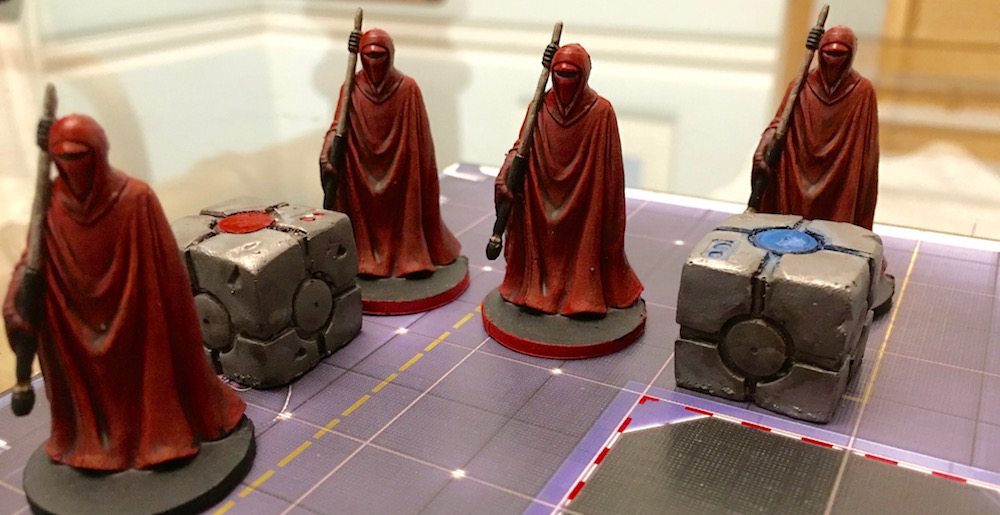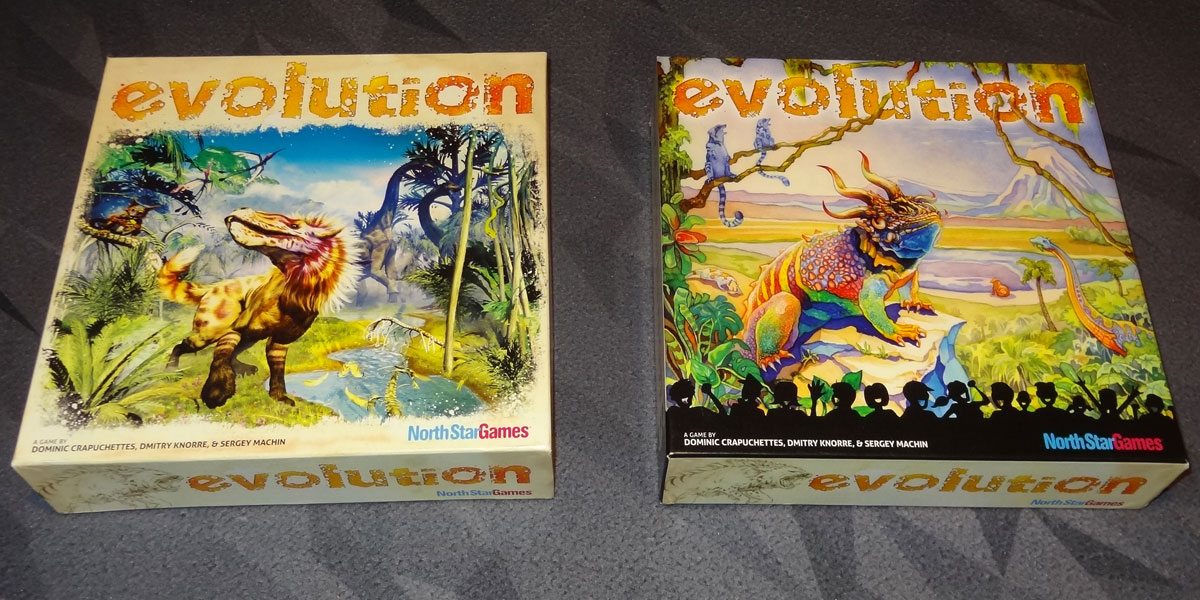
In “Reaping the Rewards,” I take a look at a crowdfunded project in its final form. Evolution was first Kickstarted by North Star Games in 2014. The first two print runs sold out quickly, and a third print run included several updates in a second edition. The first expansion, Flight, was also funded on Kickstarter this spring. Both the 2nd edition and Flight are nearly ready to ship to backers, and a few early copies may be available for demo at Gen Con this week.
I was honored to get one of the few early production copies, so here’s a quick look at how they turned out.
As you can see, the differences for Evolution start with the box. Evolution was North Star Games’ first entry into deeper strategy games; most of their previous games are party games (like Wits & Wagers or Say Anything). For the first edition, they removed their trademark silhouettes on the front cover (they were still on the back). For the second edition, the silhouette wrap-around is back to help tie it to their brand. In the Kickstarter campaign, however, some backers expressed disappointment about the silhouettes, feeling like it looked more like a casual game–so North Star actually went to the expense of printing up another set of boxes without the silhouettes, but these are a Kickstarter exclusive.
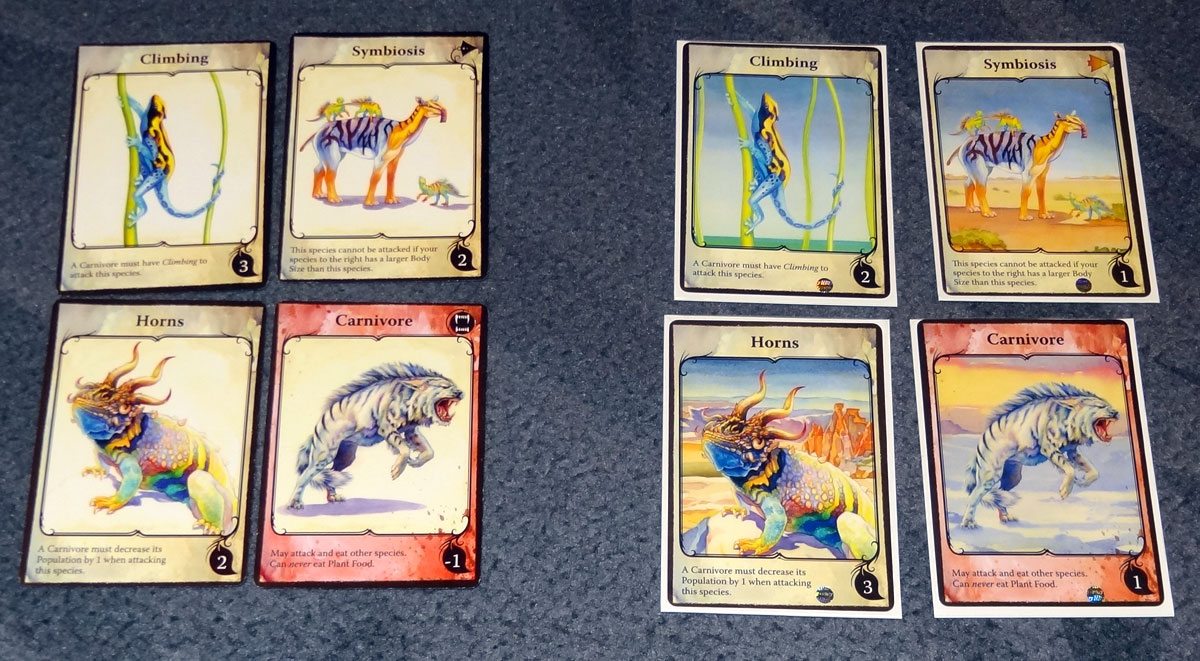
Many of the changes in the second edition were cosmetic only, like the box. All of the cards now have full-color backgrounds. In the first edition, some of the cards had full backgrounds and others had just a blank cream background. All of those cards have been updated now with new artwork.
There are a few other changes to the cards, too: for one, the food numbers have been lowered. (You can’t tell from these specific cards pictured because there are multiple copies of each card, with different food numbers.) The total amount of food on the cards is lower–it keeps new players from always playing really high food cards (sometimes to their own detriment) and also makes it more likely that there will be food shortages, forcing players to consider other evolutionary traits.
Some of the cards have been tweaked, too:
- Fat Tissue – It used to be that Fat Tissue only helped you get food in advance, but if your species died or the game ended, any food left on the card was discarded. Now it will score no matter what.
- Foraging – This card is now stronger, triggering any time the species eats Plant Food from any source.
- Pack Hunting – It used to increase your body size by 3, but now instead it adds your population to your body size. It makes more thematic sense (you need a pack for pack hunting) and can lead to some really interesting combinations, particularly those that increase population.
- Hard Shell – This is a little stronger, increasing your body size +4 instead of +3–helping to balance out the new Pack Hunting ability and making it very strong early in the game.
- Fertile – Fertile only works now if there was leftover food in the Watering Hole. Before, getting Fertile early would just max out your population, guaranteed, but now it depends on how much food there is.
- Intelligence – This can now be used by both carnivores and non-carnivores. For non-carnivores, it can be used to get extra food even before the first player feeds.
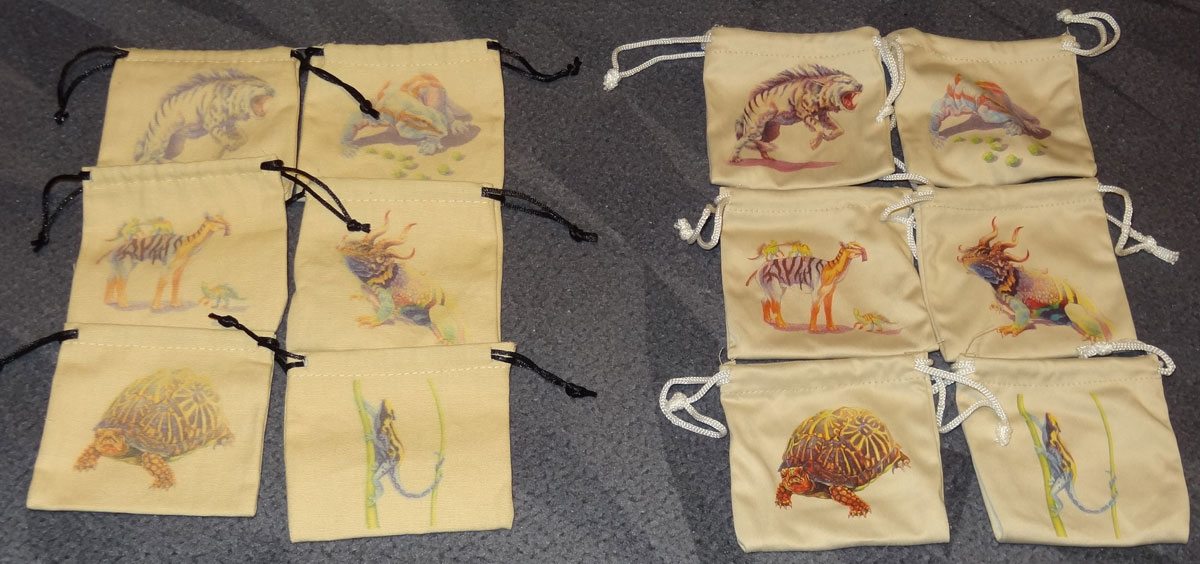
The bags in the new edition have more vibrant printing on them but are otherwise fairly similar.

Finally, the Watering Hole has been redesigned–the first edition had a lot of greenery, and it could be hard to spot the green plant food tokens (without Good Eyesight), so the new graphic has no greenery on it, making the tokens easier to see from a distance.
Some of the components, of course, stayed the same. Since I haven’t shown photos of all the finished bits, here are a few more.
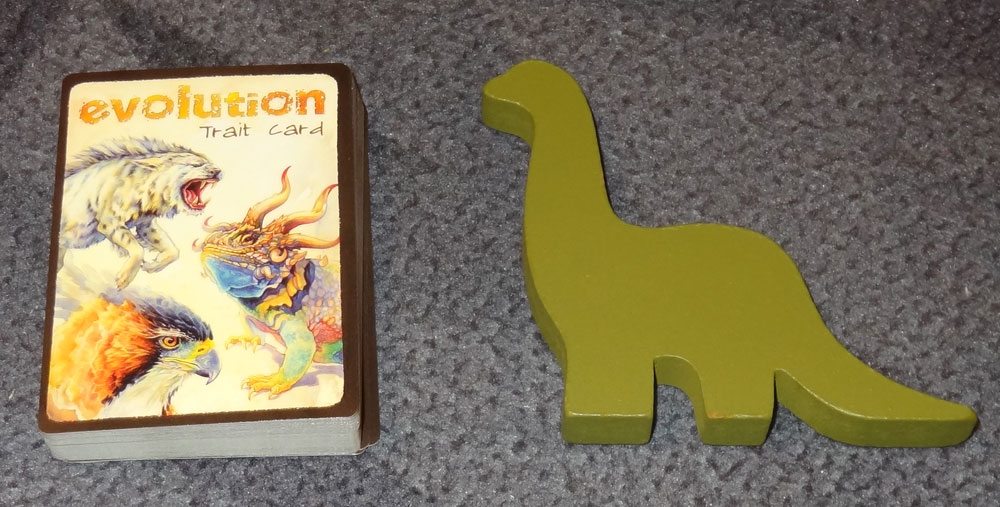
The first player token is a wooden dinosaur, and it’s pretty enormous. I think this was a stretch goal during the Kickstarter campaign, and it’s pretty fun to pass it around the table.
You can see the card backs in the photo above, too.

The species boards are nice chunky cardboard, with holes for the wooden cubes marking population and body size, and printed circles for holding food tokens. I like that the boards are double-sided, so that you can turn them vertically or horizontally based on your preference (or table size). The food circles are, helpfully, always next to the population because you’ll need to eat one food per population.
The wooden cubes are fine, but nothing exciting. Slightly larger than your typical Eurogame resource cube but not by much. The food tokens are double-sided, with plant food on one side and meat on the other (represented by various animal legs).
The trait cards are good–I think they’re not the highest quality cardstock but they’re pretty good. The illustrations are fantastic. The text is on the small side. The biggest trick is that since the title is at the top but the effects are at the bottom, there’s no good way to overlap the cards (to save table space) and still read everything. You want the titles showing because some have arrows that affect species next to them, and so your opponents can see what you have, but you want to see the bottom so you remember what they do. As you play more, of course, you’ll start to remember what various traits do, but the first few times it can get confusing.
Ok, now on to Flight.
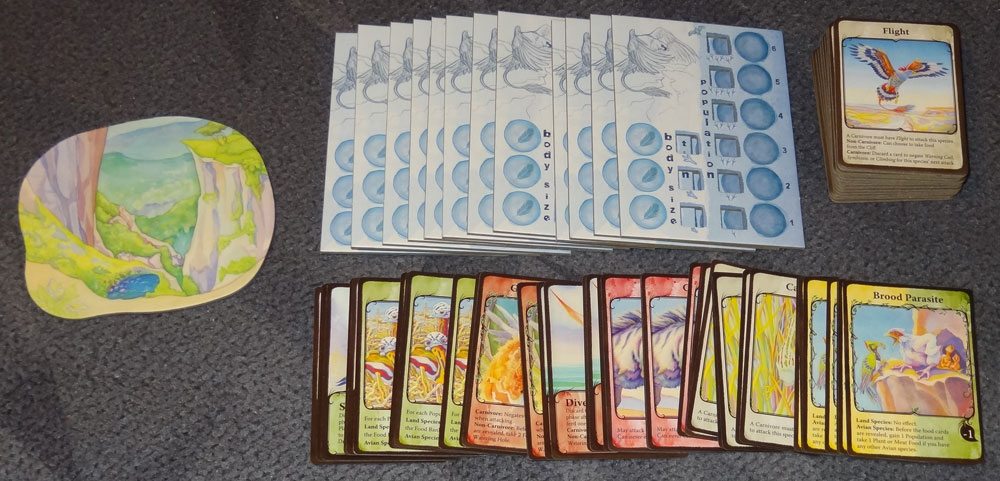
Flight comes in a smaller square box. It contains:
- 1 Cliff board
- 12 Avian Species boards
- 12 Flight Trait cards
- 34 Trait cards
- 14 Event cards
The Cliff board is smaller than the Watering Hole, but a similar shape, with an image of cliffs on it.
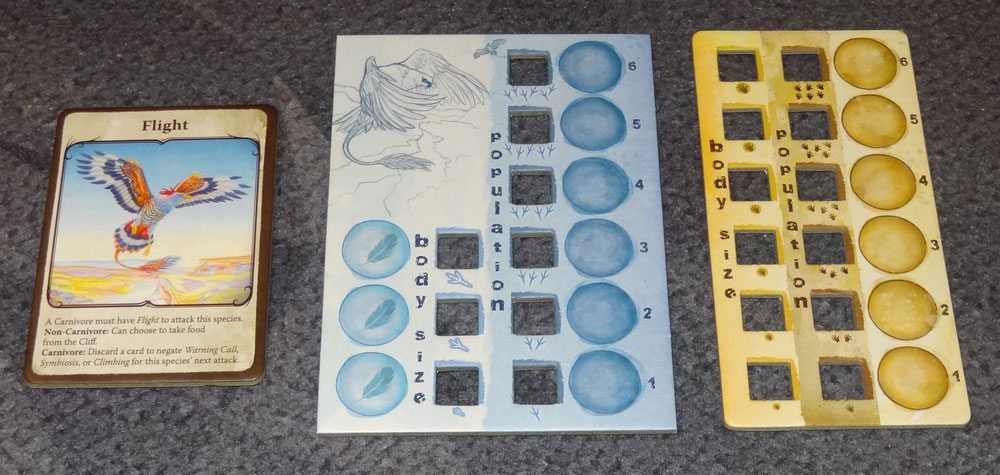
The Avian Species boards are a little different–the body size only goes up to 3 instead of six, and there are food spaces next to the body size, because you’ll have to collect food just to maintain the flying–and then discard that food rather than putting it into your scoring bag.
The Flight trait cards are actually cardboard rather than cards–they aren’t shuffled in with the other trait cards, and when you create a new species you either start a flying species or non-flying. It counts as one of your three traits per species.
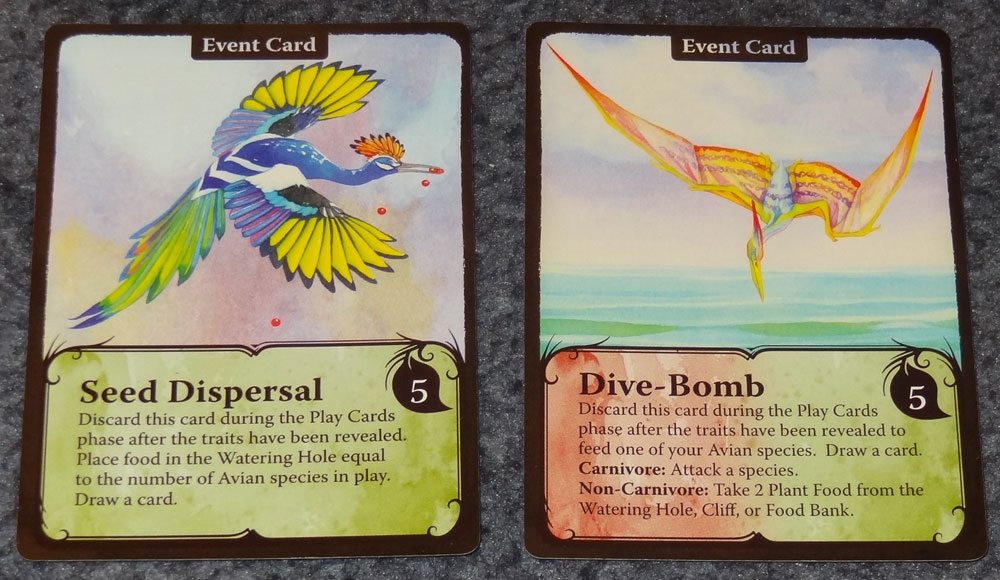
The Events are new to Flight: they are shuffled in with the rest of the trait cards, and can still be used for the food supply like the other cards. However, for their effects, they are played and then discarded, rather than added to a species. The Seed Dispersal event lets you add food to the Watering Hole based on the number of Avian species in play, providing extra food for everyone. The Dive-Bomb lets you feed one of your Avian species during the Play Cards phase, before everyone has had a chance to eat up all the food–you can use it either as a carnivore or non-carnivore.
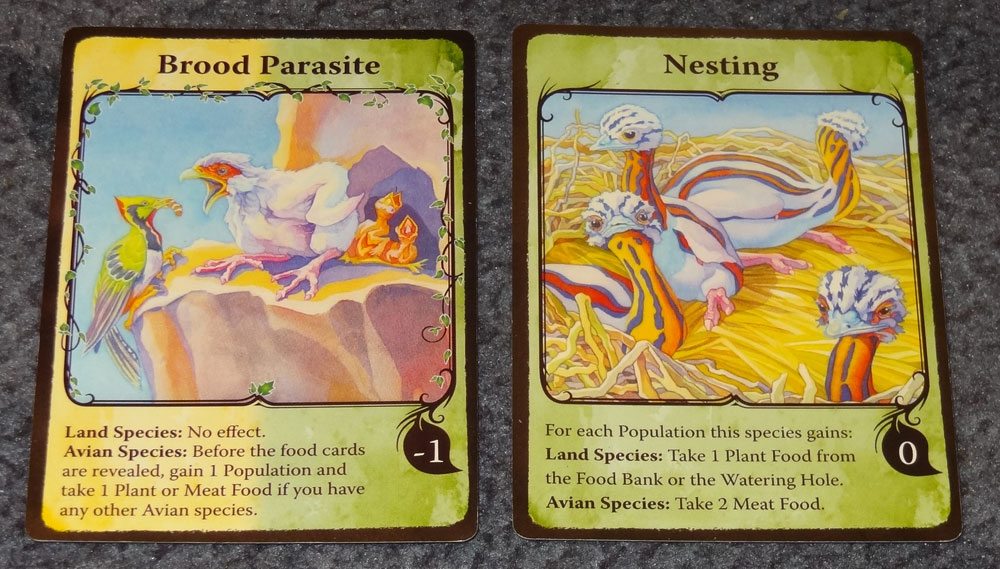
Brood Parasite only works for Avian species: basically, if you have any other Avian species, the Brood Parasite gets 1 food before the food cards are revealed. Nesting isn’t specific to Avian species, but it’s better for Avians. Land species get 1 food per population and Avian species get 2 food per population. It’s a great way to make sure you get fed, but of course it takes up one of your trait slots that could be used for defensive traits.
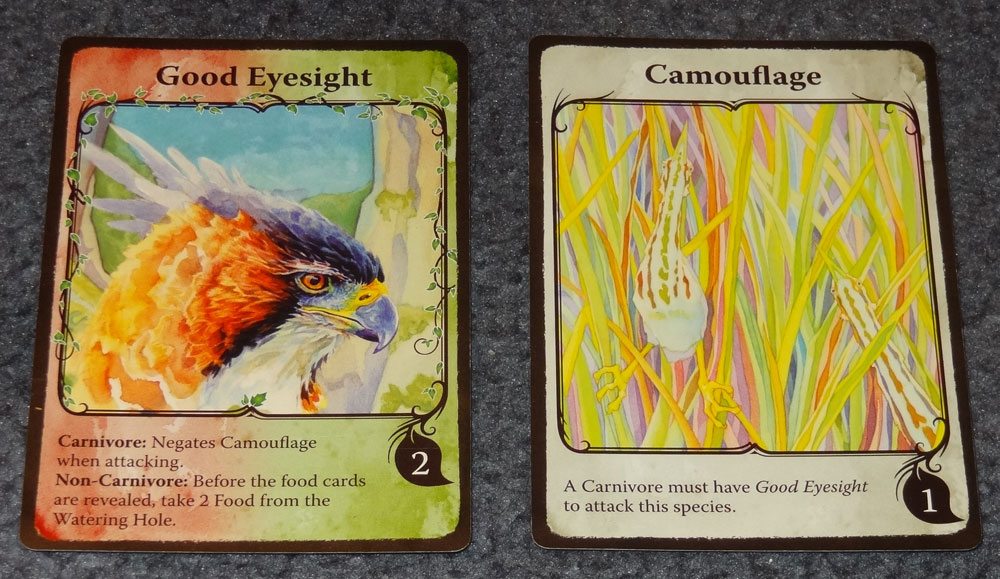
Here are two other new trait cards: Good Eyesight and Camouflage, two cards that play off each other. Camouflage prevents you from being attacked unless the predator has Good Eyesight (or some other trait that overcomes it, like Intelligence). Good Eyesight can be used for a carnivore to attack a player with Camouflage. Non-carnivores can get 2 food from the Watering Hole before food cards are revealed–but note that there has to be food left over from the previous round. I like that this is thematic–you spot food that was missed before. Neither of these traits are specific to Avian species. These two traits were in the original prototype I had of the base game, but were removed at the time, so I’m glad to see them back.
Finally, there are some additional Carnivore cards, because with all these new traits, you want to make sure there are plenty of predators to go around!
One thing I noticed was that the Flight cards aren’t marked in any way on the fronts, so if you were going to separate out the cards to play just the base game again, you’d have to just look up which ones to pull out (which might be particularly tricky for the Carnivore cards).
The Flight components almost fit into the Evolution base set box–it’s mostly the new species boards that are too big. They’re thick, so you can’t just lay them on top, but they’re too big to fit into any of the wells in the existing insert. I actually cut a small section out of the side of one of the wells (I know, it was a really tough decision) so that the Avian species boards can fit in it, and now everything fits just fine.
Overall, I’m really pleased with how both the second edition Evolution and the Flight Expansion turned out. The expansion adds some fun variety to the game, but if I’m teaching the game to a new player I’ll usually leave it out for the first play or two.
Evolution itself has been a big hit. I’ve taught it to a lot of people, and we played it a couple of times during Bristol-Liu Con. Every time I play it, I discover new combinations of traits, so it’s really never the same game twice. I love the fact that, as in real evolution, success depends on having traits best suited for the ecosystem. You can’t rely on just a few tried-and-true combinations to win–you have to see what else is going on around you. How much food is there in the watering hole? Are there any carnivores–and if so, what traits do they have and can they be countered?
You’ll get a lot of replay value just from the base set, and Flight adds a whole new layer of strategies and interactions to the game. I know North Star Games plans to invest heavily in the Evolution line, so I’m curious what comes next: aquatic species?
The first edition is available now, or you can pre-order the second edition and the expansion directly from North Star Games, which will also get some special promos with the games. And if you happen to be attending Gen Con this week, be sure to stop by North Star Games to check it out!

